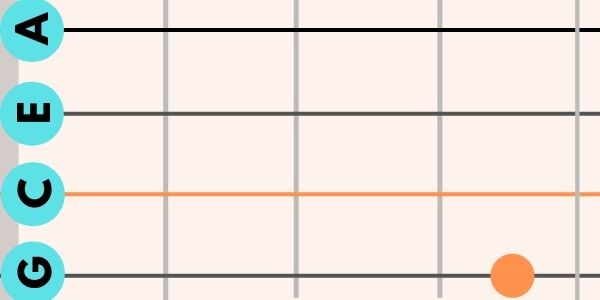One of the first steps to mastering the ukulele is to learn how to tune a ukulele without a tuner.
Tuning on the fly is an essential skill that will help you achieve the perfect tones for the ukulele songs you’ll be playing.
Whether you own a tenor, baritone, soprano, or concert ukulele, tuning is standard practice.
Understanding Standard Ukulele Tuning
For ukulele beginners, the first step to learning how to tune a ukulele is to understand standard tuning.
The instrument is often tuned to G, C, E, and A. In the past, ukulele players would use different tunings such as A, D, A, G, or A, D, F#, and B.
With a G, C, E, and A tuning, you’ll be able to create a C6 chord, and G will be your lowest note.
Once you’ve experienced working with your instrument, tuning using your open ear will be much simpler.
This general guide can give you a good idea of what a standard tuning would sound like on a concert ukulele.
- First String
When tuning your first string, you will want to get to A4. With the A string, you’ll find the highest pitch of all your ukulele strings.
- Second String
This string is meant to be tuned to E4 for standard tuning, also known as the E string. It will provide the second-lowest pitch of all your strings.
- Third String
Usually called the C string, you’ll want to tune this string to C4. It will have the lowest pitch of all your strings.
- Fourth String
As the last string on your ukulele, the bottom string should be a G4. Most players refer to it as a “low G,” but it has the second-highest pitch.
The notes will fall into the same octave when you’re strumming a standard tuned ukulele.
To help guide you, your lowest note (C4) will resonate with the middle C on the piano. Your highest pitch, A4, will be the A above the middle C on your piano.
Interestingly, standard tuning is relatively similar across all types of ukuleles, including a soprano ukulele and tenor ukuleles.
You will only notice a difference when you are playing baritone ukuleles, which are typically tuned to D3, G3, B3, and E4.
How to Tune a Ukulele Without a Tuner: The Steps
It can be intimidating to imagine tuning an instrument with little knowledge as a beginner and without a pitch pipe or clip-on ukulele tuner.
Even those in the active ukulele community can find it challenging, which is where this guide will prove most useful.
Let’s dive into the steps you can follow to get different tuning results for the perfect arrangement for ukulele.

Using a Reference Instrument and Reference Notes
If you cannot get your hands on a tuner, using a reference instrument or a smartphone app as your ukulele tuner is your best bet.
Most players use a piano, a common ukulele tuning method among plenty of ukulele players.
You can also use another reference, such as a digital sound file that shows you the tone of each note.
As you would expect, you’ll use the reference ukulele tuner to help guide you through the tuning process.
You’ll need to play the note on your ukulele simultaneously as your piano or digital file. Continue twisting the tuning peg until you achieve the same pitch as the reference notes.
How to Tune Ukulele Using a Piano
Since a piano is the most commonly used instrument for learning how to tune a ukulele without a tuner, let’s go over how you can use one.
Fortunately, the process is very straightforward, even for beginners with an acoustic ukulele.
Ideally, you’ll want to ensure each string on your ukulele corresponds with the right pitch on your piano’s keys. As a guide:
- Ukulele G corresponds with piano G
- Ukulele C corresponds with piano middle C
- Ukulele E corresponds with piano E
- Ukulele A corresponds with piano A
Using Your Ukulele
Instead of using a reference instrument or digital file for tuning, you can use the instrument itself.
This level of tuning requires a little more experience as it is all open ear tuning. Tuning a ukulele by ear can be challenging, so it’s not really for beginners.
The point of this process is to use each string as a reference for the next.
First, match your open C string to the fourth fret of your G string. These are the top two strings.

Then match your first (A) string with your second (G) string’s pitch on the second fret. These are the two outer strings.

For example, your open E should match your C string’s pitch on the fourth fret. These are the two inner strings.

Another more difficult way is to use an ear training app like Earmaster and practice the pitches of the notes in order.
It can take daily practice to learn this method, but ear training has a lot of benefits aside from tuning. It can help you know if you are out of tune, improve your ability to learn songs by ear, and make you more aware of errors (sometimes you can even catch errors in preprinted music!).
Again, these methods can be a little more challenging, especially for beginners, so reference instruments are preferred.
Things to Know When Tuning a Ukulele
Before you begin getting your instrument in tune, there are a couple of important things to note.
These ukulele expert tips can help you better understand the string instrument tuning process and how your ukulele works.
Alternate Tunings
Did you know that instead of opting for standard tuning, it is possible to use alternate options to keep your ukulele in tune?
It is relatively easy to achieve, as all you have to do is go up or down two steps per string.
For example, if you’ve tuned to G, C, E, A, you can opt to go to a G#, B, E, G#.
Alternate tunings are a fantastic way to help keep your ukulele in tune for a specific song.
It can also be a great option to get more hands-on experience tuning your ukulele.
Ukulele Tuning Apps
Getting your hands on a store-bought tuner is pretty easy, but sometimes you can forget it or the battery runs out.
As an alternative, using a smartphone tuner app can give you the same benefits for free.
There are many free tuning apps designed specifically for various instruments.
You can often download ukulele tuner apps to your phone, tablet, or even a computer.
As you play your instrument, your device picks up the sound and transmits it to the tuner.
The app then helps you achieve the perfect pitch to improve your ukulele skills.
Ukuleles Go Out of Tune
If you leave your instrument sitting for long periods, or if it’s a new ukulele, expect it to go out of tune, even with a tight tuning peg.
Even if you’ve recently tuned the strings, they can go out of tune when the instrument settles.
That said, you can expect to adjust your ukulele often at the beginning by following a step by step guide.
Over time, the strings on all types of ukuleles will settle into their correct positions.
Then, the more regularly you play, the more consistent the pitches will become.
Tuning a Ukulele
Learning how to tune a ukulele without a tuner can be a challenge, especially if you plan on doing it by ear.
However, with a reference instrument or a ukulele tuning app, finding standard ukulele tuning can be considerably simpler.
It’s a great idea to invest in a tuner or a tuning app to help keep different types of ukuleles at the perfect pitch.


